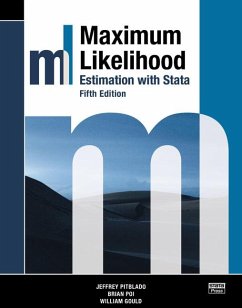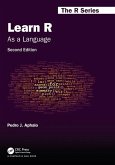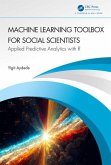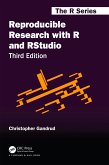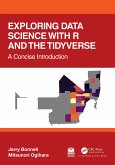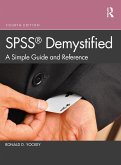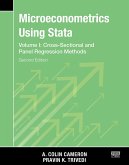- Broschiertes Buch
- Merkliste
- Auf die Merkliste
- Bewerten Bewerten
- Teilen
- Produkt teilen
- Produkterinnerung
- Produkterinnerung
Maximum Likelihood Estimation with Stata, Fifth Edition is the essential reference and guide for researchers in all disciplines who wish to write maximum likelihood (ML) estimators in Stata. Learn about ML estimation and how to write Stata code for a special ML estimator for your own research or for a general-purpose ML estimator.
Andere Kunden interessierten sich auch für
![Learn R Learn R]() Pedro J. Aphalo (Faculty of Biological and University of HelsinkiLearn R90,99 €
Pedro J. Aphalo (Faculty of Biological and University of HelsinkiLearn R90,99 €![Machine Learning Toolbox for Social Scientists Machine Learning Toolbox for Social Scientists]() Yigit Aydede (Saint Mary's University Professor)Machine Learning Toolbox for Social Scientists113,99 €
Yigit Aydede (Saint Mary's University Professor)Machine Learning Toolbox for Social Scientists113,99 €![The Mata Book The Mata Book]() William GouldThe Mata Book84,99 €
William GouldThe Mata Book84,99 €![Reproducible Research with R and RStudio Reproducible Research with R and RStudio]() Christopher GandrudReproducible Research with R and RStudio62,99 €
Christopher GandrudReproducible Research with R and RStudio62,99 €![Exploring Data Science with R and the Tidyverse Exploring Data Science with R and the Tidyverse]() Jerry BonnellExploring Data Science with R and the Tidyverse106,99 €
Jerry BonnellExploring Data Science with R and the Tidyverse106,99 €![SPSS Demystified SPSS Demystified]() Ronald D. YockeySPSS Demystified58,99 €
Ronald D. YockeySPSS Demystified58,99 €![Microeconometrics Using Stata, Second Edition, Volume I: Cross-Sectional and Panel Regression Models Microeconometrics Using Stata, Second Edition, Volume I: Cross-Sectional and Panel Regression Models]() A. Colin CameronMicroeconometrics Using Stata, Second Edition, Volume I: Cross-Sectional and Panel Regression Models113,99 €
A. Colin CameronMicroeconometrics Using Stata, Second Edition, Volume I: Cross-Sectional and Panel Regression Models113,99 €-
-
-
Maximum Likelihood Estimation with Stata, Fifth Edition is the essential reference and guide for researchers in all disciplines who wish to write maximum likelihood (ML) estimators in Stata. Learn about ML estimation and how to write Stata code for a special ML estimator for your own research or for a general-purpose ML estimator.
Hinweis: Dieser Artikel kann nur an eine deutsche Lieferadresse ausgeliefert werden.
Hinweis: Dieser Artikel kann nur an eine deutsche Lieferadresse ausgeliefert werden.
Produktdetails
- Produktdetails
- Verlag: Stata Press
- 5 ed
- Seitenzahl: 472
- Erscheinungstermin: 23. November 2023
- Englisch
- Abmessung: 235mm x 182mm x 29mm
- Gewicht: 970g
- ISBN-13: 9781597184113
- ISBN-10: 159718411X
- Artikelnr.: 69839469
- Herstellerkennzeichnung
- Libri GmbH
- Europaallee 1
- 36244 Bad Hersfeld
- gpsr@libri.de
- Verlag: Stata Press
- 5 ed
- Seitenzahl: 472
- Erscheinungstermin: 23. November 2023
- Englisch
- Abmessung: 235mm x 182mm x 29mm
- Gewicht: 970g
- ISBN-13: 9781597184113
- ISBN-10: 159718411X
- Artikelnr.: 69839469
- Herstellerkennzeichnung
- Libri GmbH
- Europaallee 1
- 36244 Bad Hersfeld
- gpsr@libri.de
Jeff Pitblado is Executive Director, Statistical Software at StataCorp. Pitblado has played a leading role in the development of ml: he added the ability of ml to work with survey data, and he wrote the current implementation of ml in Mata. Brian Poi previously worked as a developer at StataCorp and wrote many popular econometric estimators in Stata. Since then, he has applied his knowledge of econometrics and statistical programming in several areas, including macroeconomic forecasting, credit analytics, and bank stress testing. William Gould is President Emeritus of StataCorp and headed the development of Stata for over 30 years. Gould is also the architect of Mata.
Theory and practice The likelihood-maximization problem Likelihood theory
The maximization problem Estimation with mlexp Syntax Normal linear
regression Initial values Restricted parameters Robust standard errors The
probit model Specifying derivatives Additional estimation features Wrapping
up Introduction to ml The probit mode Normal linear regression Robust
standard errors Weighted estimation Other features of method-gf0 evaluators
Limitations Overview of ml The terminology of ml Equations in ml
Likelihood-evaluator methods Tools for the ml programmer Common ml options
Maximizing your own likelihood functions Appendix: More about scalar
parameters Method lf The linear-form restrictions Examples The importance
of generating temporary variables as doubles Problems you can safely ignore
Nonlinear specifications The advantages of lf in terms of execution speed
Methods lf0, lf1, and lf2 Comparing these methods Outline of evaluators of
methods lf0, lf1, and lf2 Summary of methods lf0, lf1, and lf2 Examples
Methods d0, d1, and d2 Comparing these methods Outline of method d0, d1,
and d2 evaluators Summary of methods d0, d1, and d2 Panel-data likelihoods
Other models that do not meet the linear-form restrictions Debugging
likelihood evaluators ml check Using the debug methods ml trace Setting
initial values ml search ml plot ml init Interactive maximization The
iteration log Pressing the Break key Maximizing difficult likelihood
functions Final results Graphing convergence Redisplaying output Writing
do-files to maximize likelihoods The structure of a do-file Putting the
do-file into production Writing ado-files to maximize likelihoods Writing
estimation commands The standard estimation-command outline Outline for
estimation commands using ml Using ml in noninteractive mode Advice
Writing ado-files for survey data analysis Program properties Writing your
own predict command Mata-based likelihood evaluators Introductory examples
Evaluator function prototypes Utilities Random-effects linear regression
Ado-file considerations Matäs moptimize() function Introductory examples
Restricting the estimation sample Estimation preliminaries Estimation
Results Estimation commands Regression redux Other examples The logit model
The probit model Normal linear regression The Weibull model The Cox
proportional hazards model The random-effects regression model The
seemingly unrelated regression model A bivariate Poisson regression model
Epilogue Syntax of mlexp Syntax of ml Syntax of moptimize()
Likelihood-evaluator checklists Method lf Method d0 Method d1 Method d2
Method lf0 Method lf1 Method lf2 Listing of estimation commands The logit
model The probit model The normal model The Weibull model The Cox
proportional hazards model The random-effects regression model The
seemingly unrelated regression model A bivariate Poisson regression model
References
The maximization problem Estimation with mlexp Syntax Normal linear
regression Initial values Restricted parameters Robust standard errors The
probit model Specifying derivatives Additional estimation features Wrapping
up Introduction to ml The probit mode Normal linear regression Robust
standard errors Weighted estimation Other features of method-gf0 evaluators
Limitations Overview of ml The terminology of ml Equations in ml
Likelihood-evaluator methods Tools for the ml programmer Common ml options
Maximizing your own likelihood functions Appendix: More about scalar
parameters Method lf The linear-form restrictions Examples The importance
of generating temporary variables as doubles Problems you can safely ignore
Nonlinear specifications The advantages of lf in terms of execution speed
Methods lf0, lf1, and lf2 Comparing these methods Outline of evaluators of
methods lf0, lf1, and lf2 Summary of methods lf0, lf1, and lf2 Examples
Methods d0, d1, and d2 Comparing these methods Outline of method d0, d1,
and d2 evaluators Summary of methods d0, d1, and d2 Panel-data likelihoods
Other models that do not meet the linear-form restrictions Debugging
likelihood evaluators ml check Using the debug methods ml trace Setting
initial values ml search ml plot ml init Interactive maximization The
iteration log Pressing the Break key Maximizing difficult likelihood
functions Final results Graphing convergence Redisplaying output Writing
do-files to maximize likelihoods The structure of a do-file Putting the
do-file into production Writing ado-files to maximize likelihoods Writing
estimation commands The standard estimation-command outline Outline for
estimation commands using ml Using ml in noninteractive mode Advice
Writing ado-files for survey data analysis Program properties Writing your
own predict command Mata-based likelihood evaluators Introductory examples
Evaluator function prototypes Utilities Random-effects linear regression
Ado-file considerations Matäs moptimize() function Introductory examples
Restricting the estimation sample Estimation preliminaries Estimation
Results Estimation commands Regression redux Other examples The logit model
The probit model Normal linear regression The Weibull model The Cox
proportional hazards model The random-effects regression model The
seemingly unrelated regression model A bivariate Poisson regression model
Epilogue Syntax of mlexp Syntax of ml Syntax of moptimize()
Likelihood-evaluator checklists Method lf Method d0 Method d1 Method d2
Method lf0 Method lf1 Method lf2 Listing of estimation commands The logit
model The probit model The normal model The Weibull model The Cox
proportional hazards model The random-effects regression model The
seemingly unrelated regression model A bivariate Poisson regression model
References
Theory and practice The likelihood-maximization problem Likelihood theory
The maximization problem Estimation with mlexp Syntax Normal linear
regression Initial values Restricted parameters Robust standard errors The
probit model Specifying derivatives Additional estimation features Wrapping
up Introduction to ml The probit mode Normal linear regression Robust
standard errors Weighted estimation Other features of method-gf0 evaluators
Limitations Overview of ml The terminology of ml Equations in ml
Likelihood-evaluator methods Tools for the ml programmer Common ml options
Maximizing your own likelihood functions Appendix: More about scalar
parameters Method lf The linear-form restrictions Examples The importance
of generating temporary variables as doubles Problems you can safely ignore
Nonlinear specifications The advantages of lf in terms of execution speed
Methods lf0, lf1, and lf2 Comparing these methods Outline of evaluators of
methods lf0, lf1, and lf2 Summary of methods lf0, lf1, and lf2 Examples
Methods d0, d1, and d2 Comparing these methods Outline of method d0, d1,
and d2 evaluators Summary of methods d0, d1, and d2 Panel-data likelihoods
Other models that do not meet the linear-form restrictions Debugging
likelihood evaluators ml check Using the debug methods ml trace Setting
initial values ml search ml plot ml init Interactive maximization The
iteration log Pressing the Break key Maximizing difficult likelihood
functions Final results Graphing convergence Redisplaying output Writing
do-files to maximize likelihoods The structure of a do-file Putting the
do-file into production Writing ado-files to maximize likelihoods Writing
estimation commands The standard estimation-command outline Outline for
estimation commands using ml Using ml in noninteractive mode Advice
Writing ado-files for survey data analysis Program properties Writing your
own predict command Mata-based likelihood evaluators Introductory examples
Evaluator function prototypes Utilities Random-effects linear regression
Ado-file considerations Matäs moptimize() function Introductory examples
Restricting the estimation sample Estimation preliminaries Estimation
Results Estimation commands Regression redux Other examples The logit model
The probit model Normal linear regression The Weibull model The Cox
proportional hazards model The random-effects regression model The
seemingly unrelated regression model A bivariate Poisson regression model
Epilogue Syntax of mlexp Syntax of ml Syntax of moptimize()
Likelihood-evaluator checklists Method lf Method d0 Method d1 Method d2
Method lf0 Method lf1 Method lf2 Listing of estimation commands The logit
model The probit model The normal model The Weibull model The Cox
proportional hazards model The random-effects regression model The
seemingly unrelated regression model A bivariate Poisson regression model
References
The maximization problem Estimation with mlexp Syntax Normal linear
regression Initial values Restricted parameters Robust standard errors The
probit model Specifying derivatives Additional estimation features Wrapping
up Introduction to ml The probit mode Normal linear regression Robust
standard errors Weighted estimation Other features of method-gf0 evaluators
Limitations Overview of ml The terminology of ml Equations in ml
Likelihood-evaluator methods Tools for the ml programmer Common ml options
Maximizing your own likelihood functions Appendix: More about scalar
parameters Method lf The linear-form restrictions Examples The importance
of generating temporary variables as doubles Problems you can safely ignore
Nonlinear specifications The advantages of lf in terms of execution speed
Methods lf0, lf1, and lf2 Comparing these methods Outline of evaluators of
methods lf0, lf1, and lf2 Summary of methods lf0, lf1, and lf2 Examples
Methods d0, d1, and d2 Comparing these methods Outline of method d0, d1,
and d2 evaluators Summary of methods d0, d1, and d2 Panel-data likelihoods
Other models that do not meet the linear-form restrictions Debugging
likelihood evaluators ml check Using the debug methods ml trace Setting
initial values ml search ml plot ml init Interactive maximization The
iteration log Pressing the Break key Maximizing difficult likelihood
functions Final results Graphing convergence Redisplaying output Writing
do-files to maximize likelihoods The structure of a do-file Putting the
do-file into production Writing ado-files to maximize likelihoods Writing
estimation commands The standard estimation-command outline Outline for
estimation commands using ml Using ml in noninteractive mode Advice
Writing ado-files for survey data analysis Program properties Writing your
own predict command Mata-based likelihood evaluators Introductory examples
Evaluator function prototypes Utilities Random-effects linear regression
Ado-file considerations Matäs moptimize() function Introductory examples
Restricting the estimation sample Estimation preliminaries Estimation
Results Estimation commands Regression redux Other examples The logit model
The probit model Normal linear regression The Weibull model The Cox
proportional hazards model The random-effects regression model The
seemingly unrelated regression model A bivariate Poisson regression model
Epilogue Syntax of mlexp Syntax of ml Syntax of moptimize()
Likelihood-evaluator checklists Method lf Method d0 Method d1 Method d2
Method lf0 Method lf1 Method lf2 Listing of estimation commands The logit
model The probit model The normal model The Weibull model The Cox
proportional hazards model The random-effects regression model The
seemingly unrelated regression model A bivariate Poisson regression model
References

